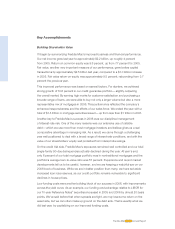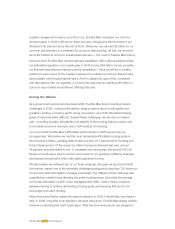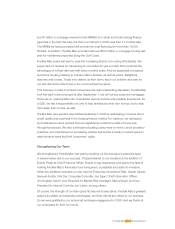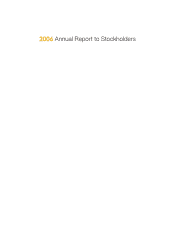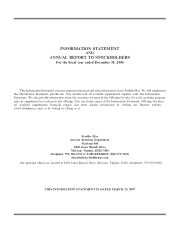Freddie Mac 2006 Annual Report Download - page 14
Download and view the complete annual report
Please find page 14 of the 2006 Freddie Mac annual report below. You can navigate through the pages in the report by either clicking on the pages listed below, or by using the keyword search tool below to find specific information within the annual report.
set in accordance with our charter. These lower rates help make home ownership aÅordable for more families and individuals
than would be possible without our participation in the secondary mortgage market.
Residential Mortgage Debt Market
We compete in the large and growing U.S. residential mortgage debt market. This market consists of a primary
mortgage market that links homebuyers and lenders and a secondary mortgage market that links lenders and investors. At
December 31, 2006, our Total mortgage portfolio was $1.8 trillion, while the total U.S. residential mortgage debt
outstanding was estimated to be approximately $10.9 trillion.
Growth in the U.S. residential mortgage debt market is aÅected by several factors, including changes in interest rates,
employment rates in various regions of the country, home ownership rates, home price appreciation, lender preferences
regarding credit risk and borrower preferences regarding mortgage debt. The amount of residential mortgage debt available
for us to purchase and the mix of available loan products are also aÅected by several factors, including the volume of single-
family mortgages meeting the requirements of our charter and the purchase and securitization activity of other Ñnancial
institutions. See ""RISK FACTORS.''
Following several years of substantial growth in the residential mortgage market, driven by historically low interest rates
and a strong housing market with record home sales and signiÑcant home price appreciation, the residential mortgage
market slowed in 2006. Home sales declined, inventories of homes for sale increased and the rate of home price appreciation
slowed. However, mortgage rates remained low by historical standards and continued to contribute to demand in the
residential mortgage market.
Home price appreciation is an important market indicator for us because it represents the general trend in value
associated with the single-family mortgage loans underlying our Mortgage Participation CertiÑcates, or PCs, and Structured
Securities. As home prices appreciate, the risk of borrower defaults generally declines and the severity of credit losses also
declines. Estimates of nationwide home price appreciation varied for 2006, with some indicating a slight overall decline in
home prices and others indicating moderate growth. However, by any measure, the nationwide rate of home price
appreciation is well below that seen in recent years and we expect that it will continue to weaken in the near term. Despite
the slowdown in the housing market, total residential mortgage debt outstanding in the U.S. grew by an estimated 9 percent
in 2006 as compared with 14 percent in 2005. We expect that the amount of total residential mortgage debt outstanding will
continue to rise in 2007, though at a slower rate than in the past few years. Table 1 includes some important indicators for
the U.S. residential mortgage market.
Table 1 Ì Mortgage Market Indicators
Year-Ended December 31,
2006 2005 2004
Home sale units (in thousands)(1) ÏÏÏÏÏÏÏÏÏÏÏÏÏÏÏÏÏÏÏÏÏÏÏÏÏÏÏÏÏÏÏÏÏÏÏÏÏÏÏÏÏÏÏÏÏÏÏÏÏÏÏÏÏÏÏÏÏÏÏÏÏ 6,737 7,463 7,161
Home price appreciation(2) ÏÏÏÏÏÏÏÏÏÏÏÏÏÏÏÏÏÏÏÏÏÏÏÏÏÏÏÏÏÏÏÏÏÏÏÏÏÏÏÏÏÏÏÏÏÏÏÏÏÏÏÏÏÏÏÏÏÏÏÏÏÏÏÏÏÏÏ 6% 13% 12%
Single-family mortgage originations (in billions) ÏÏÏÏÏÏÏÏÏÏÏÏÏÏÏÏÏÏÏÏÏÏÏÏÏÏÏÏÏÏÏÏÏÏÏÏÏÏÏÏÏÏÏÏÏÏÏÏÏ $ 3,000 $ 3,257 $2,906
ReÑnancing share of single-family mortgage originations ÏÏÏÏÏÏÏÏÏÏÏÏÏÏÏÏÏÏÏÏÏÏÏÏÏÏÏÏÏÏÏÏÏÏÏÏÏÏÏÏÏÏ 43% 44% 46%
U.S. residential mortgage debt outstanding (in billions)(3) ÏÏÏÏÏÏÏÏÏÏÏÏÏÏÏÏÏÏÏÏÏÏÏÏÏÏÏÏÏÏÏÏÏÏÏÏÏÏÏÏÏ $10,921 $10,046 $8,847
(1) Includes sales of new and existing detached single-family homes in the U.S. and excludes condos/co-ops. Sources: National Association of Realtors
news release dated February 27, 2007 (sales of existing homes) and U.S. Census Bureau news release dated February 28, 2007 (sales of new homes).
(2) Source: Freddie Mac's Conventional Mortgage Home Price Index release dated March 5, 2007.
(3) U.S. residential mortgage debt outstanding as of December 31 for 2006, 2005 and 2004. Source: Federal Reserve Flow of Funds Accounts of the
United States dated March 8, 2007.
Primary Mortgage Market Ì Our Customers
Our customers are predominantly lenders in the primary mortgage market that originate mortgages for homebuyers.
These lenders include mortgage banking companies, commercial banks, savings banks, community banks, credit unions, state
and local housing Ñnance agencies and savings and loan associations. A lender that originates a mortgage can hold the
mortgage in its own portfolio, securitize the mortgage or sell the mortgage to a secondary mortgage market investor, such as
Freddie Mac.
We acquire a signiÑcant portion of our single-family mortgages from several large lenders. In 2006, three mortgage
lenders each accounted for 10 percent or more of our single-family mortgage purchase volume. These lenders collectively
accounted for approximately 51 percent of this volume. In addition, in 2006, our top ten lenders represented approximately
76 percent of our single-family mortgage purchase volume. These top lenders are among the largest mortgage loan
originators in the U.S. We have contracts with a number of mortgage lenders that include a commitment by the lender to sell
us a minimum percentage or dollar amount of its mortgage origination volume. These contracts typically last for one year. If
a mortgage lender fails to meet its contractual commitment, we have a variety of contractual remedies, including the right
to assess certain fees. As the mortgage industry has been consolidating, we, as well as our competitors, have been seeking
2Freddie Mac



